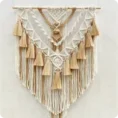Crafting Excellence: The Evolution of Handmade Industries

Imagine a world before mass production, where every object held a story. Calloused hands, honed by generations of practice, molded clay into pottery, wove threads into tapestries, and shaped wood into furniture. This wasn’t just creation; it was a conversation between the craftsman and the material, a legacy passed down through whispered techniques and unspoken understanding. This is the essence of handmade industries, a thread woven through the tapestry of human history
The Humble Beginnings
The origins of handmade goods are inseparable from human needs. The first tools, crafted from stone and bone, were born from a desire for survival. Shelter, clothing, and rudimentary weapons were all products of human ingenuity, each imbued with the maker’s skill and resourcefulness. Over time, necessity blossomed into artistry. Pottery became not just for storing food, but for decoration and ritual. Textiles transcended mere functionality, adorned with intricate patterns and imbued with cultural significance. Blacksmiths, revered for their mastery of fire and metal, forged not just tools, but exquisite weapons and awe-inspiring sculptures. The handmade industry wasn’t just about creating objects; it was about shaping culture and identity.
The Rise of Guilds and the Golden Age of Craft
As civilizations flourished, so too did the concept of specialization. Artisans banded together, forming guilds that safeguarded knowledge and ensured quality. Apprentice systems nurtured the next generation, meticulously passing down the secrets of their trade. This era witnessed the birth of iconic masterpieces – the delicate porcelain of China, the intricate mosaic art of Byzantium, the breathtaking stained-glass windows of European cathedrals. It was a time of reverence for the handmade, where the skill of the craftsman was celebrated and patrons commissioned works that reflected their wealth and status. The handmade industry thrived, a cornerstone of not just the economy, but of artistic expression and social identity.
The Industrial Revolution
The 18th century ushered in a seismic shift. The Industrial Revolution saw the rise of machines, churning out standardized goods with unprecedented speed and efficiency. While this brought affordability and accessibility, it came at a cost. The soul seemed to be leaving objects – the subtle variations, the imperfections that spoke of human touch, were replaced by sterile uniformity. The handmade industry faced an existential crisis. Guilds weakened, and the romance of craftsmanship began to fade. However, a new chapter was about to unfold.
The Handmade Renaissance
The 20th century witnessed a backlash against mass production. A renewed appreciation for the handmade emerged, fueled by a desire for unique, well-crafted objects. This wasn’t just nostalgia; it was a conscious choice. Consumers, tired of the homogeneity of factory-made goods, sought out pieces that reflected their individuality and values. The handmade industry adapted, embracing innovation while cherishing tradition. Artisans began incorporating modern techniques and sustainable practices into their work. Online marketplaces connected them with a global audience, fostering a vibrant community of makers and collectors. The handmade industry, though transformed, continued to thrive, a testament to the enduring human desire for objects that tell a story.
The story of handmade industries is a testament to human ingenuity and creativity. It’s a journey from basic necessity to artistic expression, then a struggle to survive in the face of mass production, and finally, a triumphant resurgence. Today, the handmade industry flourishes, a vibrant ecosystem where tradition meets innovation. Each handcrafted object, imbued with the maker’s skill and passion, carries a legacy that stretches back millennia. It’s a reminder that in a world increasingly dominated by machines, the human touch still holds immense value. In every stitch, every brushstroke, every curve of hand-molded clay, lies a story waiting to be told. The future of the handmade industry is bright, woven with the threads of human creativity and the enduring desire for excellence.

































